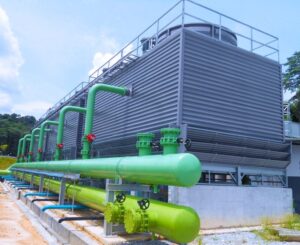How Does Weather Conditions Impact the Performance of Cooling Towers
Cooling towers are crucial components in various industrial and commercial processes, providing essential heat dissipation to maintain optimal operating conditions. However, their performance is highly influenced by weather conditions. Understanding these impacts is key to optimizing the efficiency of cooling towers and ensuring their effective operation.
Cooling towers need an optimum temperature to ensure that it can work properly. Running at high ambient temperature can bring a difference to the performance. When ambient temperatures rise, the cooling tower’s efficiency decreases. The fundamental operation of a cooling tower relies on the temperature differential between the hot water entering the tower and the cooler ambient air. High ambient temperatures narrow this differential, reducing the rate at which heat can be transferred from the water to the air. This forces the cooling tower to work harder and potentially use more energy to achieve the desired cooling effect. Conversely, cooler ambient temperatures enhance the cooling tower’s performance. The larger temperature differential allows for more efficient heat transfer, enabling the cooling tower to cool the water more effectively and with less energy consumption.
Air humidity also greatly have significant affect to the cooling towers. High humidity levels pose a significant challenge to cooling tower performance. Cooling towers operate on the principle of evaporative cooling, where heat is dissipated as water evaporates into the air. In humid conditions, the air is already saturated with moisture, reducing its capacity to absorb additional water vapor. This limits the effectiveness of the cooling process and can lead to higher temperatures in the water being returned to the system. In dry conditions, the air can absorb more moisture, enhancing the evaporative cooling process. This increases the cooling tower’s efficiency, as more heat can be removed from the water through evaporation.

Due to geographic factor, the Peninsular Malaysia are not greatly affected by wind speed. However, cooling towers in some locations are greatly impacted by wind speed. Moderate wind speeds can be beneficial, helping to disperse the warm, moist air exiting the cooling tower and bringing in fresh, cooler air. However, very high wind speeds can disrupt the airflow through the cooling tower, causing uneven cooling and potentially leading to hot spots. High winds can also cause water loss through drift, where water droplets are carried away by the wind, leading to inefficiencies and the need for more makeup water. Calm conditions can result in the accumulation of warm, moist air around the cooling tower, reducing the temperature differential and lowering efficiency. Adequate airflow is necessary to ensure effective heat dissipation.
Another condition that can give an impact is sun radiation. Direct sunlight can heat the cooling tower structure and the water within it, increasing the load on the cooling system. This additional heat input requires the cooling tower to work harder to achieve the same cooling effect, reducing its overall efficiency. Overcast or shaded conditions reduce the heating effect of solar radiation, which can aid in maintaining lower water temperatures and improving the cooling tower’s performance.
Rainfall is another weather condition that can have a dual effect on cooling tower performance. On one hand, rain can cool the ambient air and the structure of the cooling tower, which can enhance cooling efficiency. On the other hand, excessive rain can lead to operational challenges such as water ingress into the system, potential flooding, and increased maintenance requirements. In the absence of rain, the cooling tower relies entirely on its evaporative cooling process. While this is effective under low humidity conditions, prolonged dry periods may necessitate additional water management strategies to ensure continuous operation and efficiency.
Weather conditions play a pivotal role in the performance of cooling towers. High temperatures and humidity levels can reduce efficiency, while cooler and drier conditions generally enhance performance. Wind speed and solar radiation also significantly influence cooling tower operations, and rainfall presents both opportunities and challenges. By understanding and adapting to these weather-related impacts, operators can optimize the performance of cooling towers, ensuring efficient and reliable cooling for various industrial and commercial applications.
Megajana are well verse in cooling tower system and ready to give any consultation related to cooling tower maintenance.
Contact us here if you require any assistance!